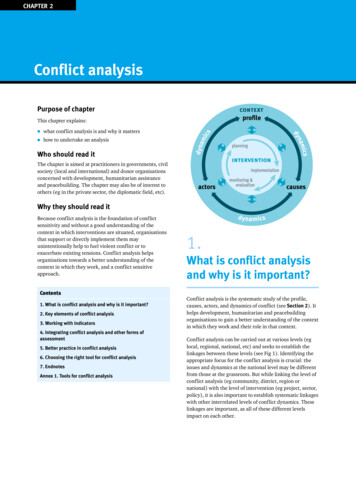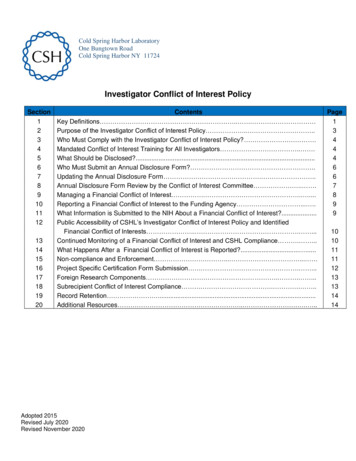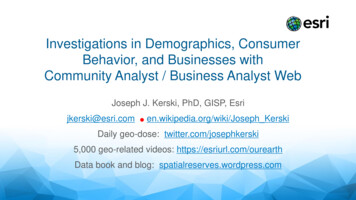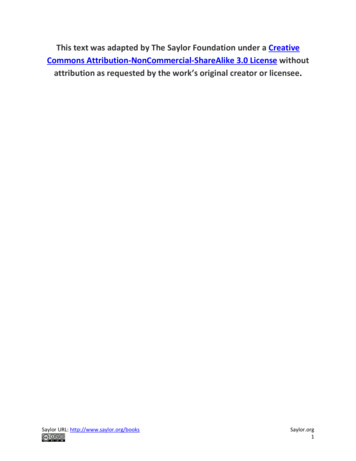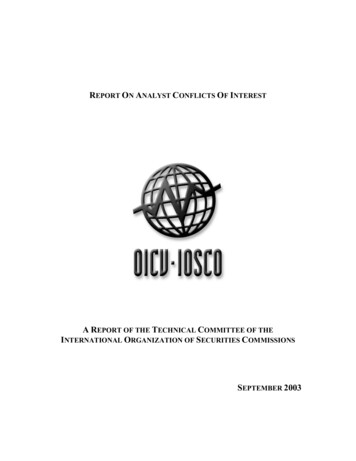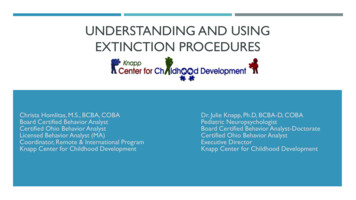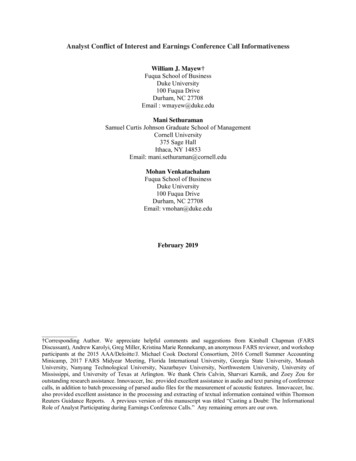
Transcription
Analyst Conflict of Interest and Earnings Conference Call InformativenessWilliam J. Mayew†Fuqua School of BusinessDuke University100 Fuqua DriveDurham, NC 27708Email : wmayew@duke.eduMani SethuramanSamuel Curtis Johnson Graduate School of ManagementCornell University375 Sage HallIthaca, NY 14853Email: mani.sethuraman@cornell.eduMohan VenkatachalamFuqua School of BusinessDuke University100 Fuqua DriveDurham, NC 27708Email: vmohan@duke.eduFebruary 2019†Corresponding Author. We appreciate helpful comments and suggestions from Kimball Chapman (FARSDiscussant), Andrew Karolyi, Greg Miller, Kristina Marie Rennekamp, an anonymous FARS reviewer, and workshopparticipants at the 2015 AAA/Deloitte/J. Michael Cook Doctoral Consortium, 2016 Cornell Summer AccountingMinicamp, 2017 FARS Midyear Meeting, Florida International University, Georgia State University, MonashUniversity, Nanyang Technological University, Nazarbayev University, Northwestern University, University ofMississippi, and University of Texas at Arlington. We thank Chris Calvin, Sharvari Karnik, and Zoey Zou foroutstanding research assistance. Innovaccer, Inc. provided excellent assistance in audio and text parsing of conferencecalls, in addition to batch processing of parsed audio files for the measurement of acoustic features. Innovaccer, Inc.also provided excellent assistance in the processing and extracting of textual information contained within ThomsonReuters Guidance Reports. A previous version of this manuscript was titled “Casting a Doubt: The InformationalRole of Analyst Participating during Earnings Conference Calls.” Any remaining errors are our own.
Analyst Conflict of Interest and Earnings Conference Call InformativenessAbstractWe examine the informativeness of dialogues between managers and analysts during earnings conferencecalls. We distinguish between favored and disfavored analysts who face different conflict of interest levelswhen dealing with management. Favored analysts curry favor with management by providing favorablerecommendations and achievable earnings forecasts. While market participants may dismiss dialogues withfavored analysts as biased and uninformative, it is also possible that favored analysts enjoy more privateaccess to management leading to more informative dialogues. Using intra-day absolute stock price reactionsaround specific analyst-manager dialogues to proxy for informativeness, we find that manager dialogueswith disfavored analysts are more informative. Analysis of dialogue characteristics reveals that disfavoredanalysts elicit information from management by engaging in longer dialogues with more back-and-forthiterations relative to favored analysts. Stock prices directionally respond to both the analyst’s linguistic toneand the manager’s voice pitch. While favored analysts exhibit a more positive tone compared to disfavoredanalysts, managers reduce their voice pitch to signal dominance regardless of how favored the analyst is.We find no evidence that disfavored (favored) analysts systematically drive stock prices down (up). Overall,the capital market effects of earnings conference calls are far more nuanced than previously documented.Key words: Conference Calls, Financial Analysts, Favored Analysts, Price Formation, MarketMicrostructure, Conflict of Interest
Analyst Conflict of Interest and Earnings Conference Call Informativeness1. IntroductionAcademics and regulators have long been interested in how conflicts of interest impact sell sideanalysts (Mehran and Stulz 2007). In this paper, we focus on the informativeness of publicly broadcastedearnings conference call interactions between analysts and managers. We specifically examine whether thecapital market responds differently to analyst-manager dialogues based on whether an analyst is favored ordisfavored by management. Our investigation is motivated by research showing that sell side analystsoverall are responsible for much of the informativeness of earnings conference calls (Matsumoto, Pronk,and Roelofsen 2011) and by SEC concerns about analyst conflicts of interest in the conference call setting(Cox 2005; Smith, Alfonso, and Hogan 2018). How informative the capital market finds conference calldialogues of favored and disfavored analysts is unclear as there are three possibilities.First, one might expect a weaker response to favored analyst dialogues relative to disfavoredanalysts. This prediction follows from research documenting that the capital market is adept at identifyinganalyst conflicts of interest as evidenced by investors discounting favorable stock recommendations issuedby analysts facing institutional investor (Gu, Li, and Yang 2013) or investment banking (Agrawal and Chen2008) pressure.In contrast, one might expect precisely the opposite, whereby investors respond more strongly todialogues from favored analysts. This opposing prediction stems from the source of the conflict of interest.When facing institutional investor (investment banking) conflicts, analysts inject bias into their workproduct in exchange for trading commissions (investment banking fees). When managers serve as thesource of the conflict, analysts curry favor in exchange for access to management’s information. Researchdocuments that favored analysts obtain more private access to management (Soltes 2014), and such privateaccess results in both more accurate earnings forecasts and stronger price responses to analyst outputs (Chenand Matsumoto 2006; Green, Jame, Markov, and Subasi 2014). These findings imply that the bias analystsmight inject into their work product to curry favor and obtain managerial access is outweighed by the1
informational benefits they receive from the access itself (Ke and Yu 2006). During a conference call, bothfavored and disfavored analysts obtain public access to management. However, if favored analysts havedeveloped a deeper understanding of the firm through their private access to management, they may askquestions that are more informative and elicit answers that are more informative to market participantsduring the conference call.The third possibility is that there may be no observable differences in capital market responses todialogues with favored and disfavored analysts. Examining conference call dialogue differences isconditional on managers already allowing the analyst through the question queue. Prior research (Mayew2008) has established that managers are more (less) likely to engage in public conference call dialogueswith more favorable (unfavorable) analysts.Given this preferential treatment, whether meaningfulheterogeneity remains among the analysts who are allowed to publicly speak with managers is unclear.To empirically assess these competing predictions, we hand-collect a sample of 19,605 analystmanager dialogues, which contain more than 215,000 turns-at-talk, from 2,455 earnings calls.1 Our samplerequires the manual identification of the point in time where one manager-analyst interaction ends and thenext one begins, by restreaming, recording, and listening to the audio broadcast of each conference call.2Using intra-day stock price data at each manager-analyst changeover, we assess how stock prices changeas managers speak with individuals in the conference call question and answer session. Following priorresearch, we classify how favored a given sell-side analyst is likely to be in the eyes of management basedon both the stock recommendation of the analyst immediately prior to the call (Chen and Matsumoto 2006)and whether the analyst provided an achievable quarterly earnings forecast (Ke and Yu 2006). Analystswith buy or strong buy (hold, sell, or strong sell) recommendations and whose earnings forecasts are metor beaten (missed) are classified as favored (disfavored) analysts. Analysts with favorable (unfavorable)1A “turn-at-talk” is a continuous stream of words spoken by a single participant in the call (analyst or a manager).Inferring manager-analyst changeover times from conference call transcripts is problematic for conducting intradayanalysis because transcripts purge operator instructions and do not provide information on speech rates or pausesduring discourse. These issues make it difficult to precisely identify the point of changeover between speakers, andin turn the ability to identify the appropriate intra-day price for analysis. This necessitates the manual parsing of audiofiles.22
stock recommendations but whose forecasts were missed (met or exceeded) are categorized as intermediatecases in terms of currying favor with management.Using the absolute stock return observed during the manager-analyst dialogue as our measure ofinformativeness, we find that favored analysts elicit market reactions that are smaller in magnitude whencompared to disfavored analysts. The two intermediate cases exhibit market responses that are similar inmagnitude and fall in between the magnitudes observed for the favored and disfavored cases. These resultssuggest that informativeness is decreasing in how favorably the manager views the analyst, which is moreconsistent with market participants discounting the dialogues of conflicted analysts rather than conflictedanalysts generating dialogues with more information.That our evidence suggests disfavored analyst dialogues are more informative does not, however,tell us what factors drive the differential informativeness. We therefore consider whether disfavoredanalysts generate dialogues that contain a higher quantity of value relevant information or information ofhigher credibility, both of which could generate a heightened market response. Regarding the quantity ofvalue relevant information, we acknowledge that identifying important topical issues for a given firm in agiven quarter is very subjective, and so we choose four proxies that do not require researcher discretion.The first proxy is the length of the dialogue, which the extant literature uses to proxy for information content(Matsumoto et al. 2011; Frankel, Mayew, and Sun 2010). The second proxy is an indicator for whether ornot the dialogue contains forward-looking guidance. Forward-looking information has been shown to bemore value relevant in the sense that stock prices respond more to forward-looking than backward lookinginformation (Li 2010). We are able to precisely ascertain whether a given dialogue contains guidance bycross-referencing dialogue content to Thomson Reuters Guidance Reports. The third proxy is the order inwhich the analyst appears on the call, given that investor relations best practices suggest taking the mostimportant questions first (Stewart 2007) and research showing that analysts who ask questions early in thecall are more accurate forecasters (Cen, Chen, Dasgupta, and Ragunathan 2016). Finally, our fourth proxyis the number of turns-at-talk between the analyst and management. Incremental to the overall length ofthe dialogue, turns-at-talk proxy for the range of topics a given analyst covers in a dialogue.3
We find that dialogues are more informative when they are longer in duration and contain moreturns-at-talk. These effects are incremental to one another and vary depending on whether the analyst isfavored or disfavored. We find disfavored analysts have longer dialogues, with more turns-at-talk, relativeto favored analysts. We also find that earlier dialogues are more informative than later dialogues, butguidance does not impact informativeness incrementally.The lack of incremental information content in guidance dialogues is attributable to the fact thatsuch dialogues tend to be longer, occur earlier in the call, and have more turns-at-talk. In other words, theguidance dialogue informativeness is subsumed by other related dialogue attributes. However, we find littlesystematic evidence that a discussion of guidance or the order of analyst appearance is associated with howfavored the analyst is in the eyes of management. Regarding guidance, favored analysts are more likely todiscuss guidance relative to both disfavored analysts and analysts with favorable stock recommendationswhose forecasts have been missed. Moreover, analysts holding unfavorable recommendations whoseforecasts have been met are as likely as favored analysts to discuss guidance with management. Thesefindings imply that the meeting of individual analyst forecasts is a key factor responsible for whether ananalyst will discuss guidance with management, corroborating the survey results in Graham et al. (2005).Regarding order of appearance, favored analysts are not ordered in a manner that statistically differs fromdisfavored analysts.Turning to the credibility of dialogue information, prior research suggests disfavored analysts areless likely to inject or elicit optimistic sentiment that assists management hide bad news (Cohen, Lou, andMalloy 2017). This implies disfavored analyst dialogues should be relatively more negative than favoredanalyst dialogues. Because negative information is more credible than positive information (Jennings 1987;Rogers and Stocken 2005), one may in turn observe larger magnitude market responses to dialogues withdisfavored analysts because stock prices decrease more in response to negative information than increasein response to positive information. To test this prediction, we use signed stock returns. We, however, findno evidence that disfavored analysts drive stock prices down relative to favored analysts.4
We next examine whether the capital market responds to specific verbal and nonverbal signalscontained within the dialogues. Specifically, we examine whether the words and sounds expressed duringthe analyst-manager dialogues influence stock price changes. Based on prior work, we expect linguisticcues to be positively related to stock returns. Our linguistic cues include the linguistic tone (i.e. positiveminus negative tone), separately measured for both analysts and managers, as well as the proportion ofanalyst praise words (Milian and Smith 2017).Regarding sounds, a series of experimental studies in evolutionary psychology finds that humanvoice pitch decreases (increases) when a speaker engages in conversations with a competitor who thespeaker perceives to be less (more) dominant (Tusing and Dillard 2000; Puts, Gaulin, and Verdolini 2006;Cheng, Tracy, Ho, and Henrich 2016). Applying this literature to our setting, we take managers as thespeaker and analysts as the competitor and predict that the capital market will view lower-pitched dialoguesfavorably, as credibility is enhanced through dominance (Mikkelson, Sloan, and Hesse 2017). We measurevoice pitch changes of managers by comparing the average voice pitch during the dialogue with that in thepresentation, given the presentation captures the normal speaking voice of the manager prior toconfrontation by analysts in the conference call Q&A (Mayew, Parsons, and Venkatachalam 2013).With respect to linguistic cues, we find that stock returns during the dialogue are increasing in thelinguistic tone of analysts but not that of managers (Price, Doran, Peterson, and Bliss 2012; Chen, Nagar,and Schoenfeld 2017). Favored analysts exhibit more favorable tone than disfavored analysts do. We alsofind stock prices increase when managers exude dominance in the conversation, as captured throughchanges in voice pitch. However, voice pitch changes do not vary with how favored the analyst is. Allcategories of sell side analysts engage in dialogues that contain a statistically equivalent amount ofmanagerial dominance as measured through changes in voice pitch.As a collection, our evidence suggests that disfavored analysts engage in more informativeconference call dialogues than favored analysts, as evidenced by larger absolute stock price reactions.These larger stock price reactions result from disfavored analyst dialogues being longer and containingmore turns-at-talk, which captures the elicitation of more information and/or reduction of uncertainty about5
existing information. The larger absolute stock price changes for disfavored analysts do not occur due tostock prices systematically changing in a particular direction. The lack of a differential directional priceresponse to disfavored analysts relative to favored analysts overall reflects the fact that manager-analystdialogues contain multiple important market moving signals including linguistic sentiment of analysts,which vary between favored and disfavored analysts, and voice pitch changes of managers, which does notvary with how favored or disfavored an analyst is.Our paper makes four primary contributions. First, we provide new evidence on conflicts of interestbetween managers and analysts in the conference call setting, which is of interest to regulators (Cox 2005).Our investigation of stock prices during conference call dialogues suggests the market is attuned to analystconflicts as disfavored analyst dialogues are viewed as more informative. This finding implies thatinformational benefits of access to management (Chen and Matsumoto 2006; Ke and Yu 2006; Soltes 2014;Green et al. 2014) that favored analysts enjoy is counteracted by the discount the market applies to favoredanalyst dialogues. Second, our paper is the first to offer a comprehensive assessment of the anatomy of theQ&A portion of earnings conference at the conversation level. Prior research primarily focuses on thecontent of conference calls overall or by section (i.e. presentation vs Q&A) of the call (Price et al., 2012;Chen et al., 2017; Milian and Smith, 2017) without considering features of individual dialogues betweenmanagers and specific analysts. We are able to provide this dialogue level assessment by assembling aunique dataset derived from original audio recordings of conference calls. Third, Matsumoto et al. (2011)document that the informativeness of conference call Q&A portion is driven by analyst involvement. Webuild on this finding by demonstrating which analysts matter to the capital market and why they matter.Fourth, by studying both the text and the audio of manager-analyst dialogues, we provide new evidence onhow different analysts shape what investors hear and react to during such calls. This responds to the callin Kothari, So, and Verdi (2016) for a better understanding of the analyst’s role in price formation.6
2. Sample Selection and Research Design2.1 Sample SelectionOur sample consists of 2,455 earnings conference calls of S&P 1500 firms that occurred during theperiod 2008-2010 for which we are able to obtain digital audio recordings. We focus on S&P 1500 firmsfollowing Hollander, Pronk, and Roelofsen (2010), who note that S&P 1500 firms’ are sufficiently liquidto facilitate detection of intra-day pricing effects during conference calls. Additionally, S&P 1500 firmsrepresent important firms in the economy that are actively followed by financial analysts, which increasesthe relevance of the Q&A portion of conference calls. We restrict our sample to calls that occur duringtrading hours so that intra-call stock returns can be computed reliably using TAQ data.3To obtain audio recordings, we manually restream and record conference calls posted onwww.earnings.com, a website that previously served as Thomson Reuters’ individual investor portal duringour data collection period. Restreaming capability is typically available for one quarter to one year fromthe initial date of broadcast. We require audio files so we can precisely identify when one speaker finishesand another speaker begins speaking during the call. These time-stamps in turn allow for the precisecalculation of stock returns within the call. Using transcripts instead of audio files to approximate whenspeakers transition is problematic because conference call transcripts from commercial providers do nottake into account varying speech rates among speakers, pauses, or speech hesitations. Moreover, operatorinstructions spoken during the live broadcast are typically purged from commercial transcripts, making itvery difficult to infer the true time of day a given analyst speaks during a call. Audio files also allow us tomeasure acoustic features of speech that investors would hear when listening to the call (Mayew andVenkatachalam 2012; Mayew, Sharp, and Venkatachalam 2013).3See Appendix B for details related to procuring and preparing TAQ data for analysis. After-hours trading data is notavailable to assess whether our findings generalize to conference calls held after trading hours. As Matsumoto et al.(2011) note, it is possible that the results observed from an analysis of conference calls held during trading hours maynot generalize to calls that occur after trading hours. Additionally, our sample period occurs during the financial crisis,which may additionally limit the extent to which our results generalize to other periods.7
We manually parse the aggregate conference call audio into individual turns-at-talk audio files byrelying on human listeners, as it is not feasible to automate this process reliably. Because managers andanalysts take turns talking, we utilize conference call transcripts, obtained from the Thomson ReutersStreetEvents database, to assist the listener in identifying each unique turn-at-talk during the broadcast.Each identified turn-at-talk during the conference call is then isolated into an audio file for measuringacoustic features and a text file for measuring linguistic features. There are 250,476 unique turns-at-talk inthe entire conference call corpus we examine, of which 238,546 occur in the Q&A portion of the call.4To study how the capital market responds to specific manager-analyst interactions, we isolate thesequence of turns-at-talk that comprise each manager-analyst dialogue in the Q&A portion of theconference call.Each dialogue starts with a question posed by a unique analyst and contains the fullconversation between that specific analyst and the management team, two examples of which are providedin Appendix E. Each dialogue can contain multiple questions by an individual analyst and correspondingresponses from members of management. The dialogue ends when a different analyst asks a question.There are 19,605 manager-analyst dialogues in our sample that, on average, last 3.8 minutes.We proxy for how favored an analyst is in the eyes of management using both whether theindividual analyst provided favorable stock recommendation (Chen and Matsumoto 2006) and whether theanalyst provided an achievable quarterly earnings forecast (Ke and Yu 2006). We obtain both proxies fromI/B/E/S in a two-part process. First, we utilize the I/B/E/S recommendation file, which contains the nameand brokerage of each sell-side analyst providing a stock recommendation on the firm. We manually matchthe I/B/E/S recommendation file information with the name and affiliation of the analyst from the transcriptheader. With this match, we then use the unique analyst identifier (per the I/B/E/S recommendation file)to identify the same analyst’s earnings forecast per the I/B/E/S unadjusted detail file. Comparing theearnings forecast with the I/B/E/S actual earnings allows us to ascertain whether the analyst provided anachievable earnings forecast or not. While the majority of manager-analyst dialogues in our sample involve4About 10% of the turns in a conference call correspond to operators that moderate the call.8
analysts that are identifiable in I/B/E/S, some are not. While decomposing the Q&A portion of the call, weretain dialogues pertaining to conference call participants that we cannot match to I/B/E/S as a basereference group in our empirical analysis. We cannot objectively measure how favored an analyst in thebase group might be as it contains a mix of sell-side analysts who do not yet follow the firm (Jung, Wong,and Zhang 2015) along with buy-side analysts, media personnel, and other unidentified participants (Call,Sharp, and Shohfi 2018).We obtain other variables for our analysis regarding analysts, stock prices, and firm characteristicsfrom I/B/E/S, CRSP/TAQ, and Compustat, respectively. We also obtain information on whether individualmanager-analyst dialogues contain forward-looking guidance by referring to Thomson Reuters GuidanceReports. Guidance reports tabulate for each fiscal year all of the guidance provided by a firm, bothquantitative and qualitative, as well as the source of the guidance. For example, if a firm issues guidancepertaining to bad debt expense during a conference call, the guidance report provides the supportingevidence for the forecast by excerpting the specific sentences from the conference call that underpin theforecast. In Appendix C, we outline the process for identifying whether a given dialogue contains anyforward-looking information as per the guidance report.2.2 Research DesignTo examine the informativeness of managerial interactions with favored and disfavored analysts,we begin by estimating the following OLS regression with robust standard errors clustered at the call levelfor manager-analyst dialogue d on firm-quarter conference call c (subscripts suppressed):DL ABSRET a0 a1DL BUY MEET a2DL BUY MISS a3DL NBUY MEET a4DL NBUY MISS Σ Controls (1)In equation (1), the variable prefix “DL” signifies the analysis is conducted at the dialogue level.DL ABSRET is the absolute stock price return surrounding the manager-analyst dialogue. The coefficientsa1 through a4 capture the effect of sell-side analysts currying favor through a combination of favorable stockrecommendations (Chen and Matsumoto 2006) and achievable quarterly earnings targets (Ke and Yu 2006).DL BUY MEET is an indicator variable that equals one for favored analysts (i.e. analysts that issue a9
Buy/Strong Buy stock recommendation and whose forecasts have been met or exceeded), and zerootherwise. DL NBUY MISS is an indicator variable that equals one for disfavored analysts (i.e. analyststhat issue a Sell/Strong Sell/Hold stock recommendation and whose forecasts have been missed), and zerootherwise. DL BUY MISS and DL NBUY MEET are indicator variables that capture the intermediatecases. DL BUY MISS is an indicator variable set to one for analysts with Buy/Strong Buyrecommendations whose forecasts have been missed, and zero otherwise. DL NBUY MEET is anindicator variable set to one for analysts with Sell/Strong Sell/Hold recommendations whose forecasts havebeen met or exceeded, and zero otherwise.Controls is a vector of variables that captures the quality of the analyst speaking with managementand the general information environment of the firm. High quality analysts elicit stronger market responses(Gleason and Lee 2003) and we proxy for analyst quality by including indicator variables for whether theanalyst is an all-star (DL ALLSTAR) and whether the analyst works for a prestigious brokerage(DL BROKER). We also control for variables that capture a firm’s information environment by includingproxies such as firm size (LnSIZE), dispersion of the consensus earnings estimate (DISPERSION), and themagnitude of the consensus earnings surprise ( UE ).5Our primary interest lies in the difference between coefficient a1 and a4. On the one hand, if marketparticipants perceive favored analysts as conflicted and consequently discount their interactions withmanagement, we would expect a1 a4. On the other hand, if favored analysts possess better insights aboutthe firm as a result of their relationship with management, their interactions with management may beparticularly informative and result in a1 a4. Finally, if managers do not allow sufficiently disfavoredanalysts onto the call (Mayew 2008) there may be little observable difference among (dialogues with)analysts that do participate on the call. In such a case we would observe a1 a4.5We conduct sensitivity checks on our variable choices and definitions in Appendix D. In particular, we consideranalyst experience with the firm as another proxy for analyst quality. We also assess whether our results are sensitiveto using the absolute stock recommendation level as a basis for categorizing analysts as favored or disfavored. Ratherthan using the favorableness of the analyst’s stock recommendation level on an absolute basis, we consider stockrecommendation favorableness on a basis relative to analysts participating on the call. Our conclusions are notsensitive to these research design choices.10
3. Empirical Analysis3.1 Sample ValidationBefore proceeding to estimate equation (1) we first validate our sample by ensuring that the resultsin Matsumoto et al. (2011) hold in our sample. This is important because our tests are designed toinvestigate how analysts might differentially influence price responses during the Q&A under theassumption that analysts play a key role in shaping capital market perceptions of the firm. Given our sampleis restricted to S&P 1500 firms for which we are able to obtain conference call audio recordings, our sampleof 2,455 conference calls is much smaller than the 10,062 conference calls used in Matsumoto et al. (2011).This validation exercise also mitigates any concern regarding generalizability of our results, given oursample is much shorter and overlaps with the financial crises period. We estimate the following empiricalspecificationsABS ABNRETPR α0 α1 ABSRETDAYB4 ε(2)ABS ABNRETPR 0 1 ABSRETDAYB4 2 NUM ANA 3 NUM ANA2 ε(3)ABS ABNRETQA β0 β1 ABSRETDAYB4 β2 ABS ABNRETPR ε(4)ABS ABNRETQA 0 1 ABSRETDAYB4 2 ABS ABNRETPR 3 NUM ANA 4 NUM ANA2 ε (5)ABS ABNRETPR refers to the absolute abnormal return during the presentation section of the call,ABS ABNRETQA is the absolute abnormal return during the Q&A section of the call, andABSRETDAYB4 is the absolute return for the 24-hour period prior to the start of the conference call, whichcaptures the market response to the earnings press release. When computing abnormal returns we use thesame period o
overall are responsible for much of the informativeness of earnings conference calls (Matsumoto, Pronk, and Roelofsen 2011) and by SEC concerns about analyst conflicts of interest in the conference call setting (Cox 2005; Smith, Alfonso, and Hogan 2018). How informative the capital market finds conference call

